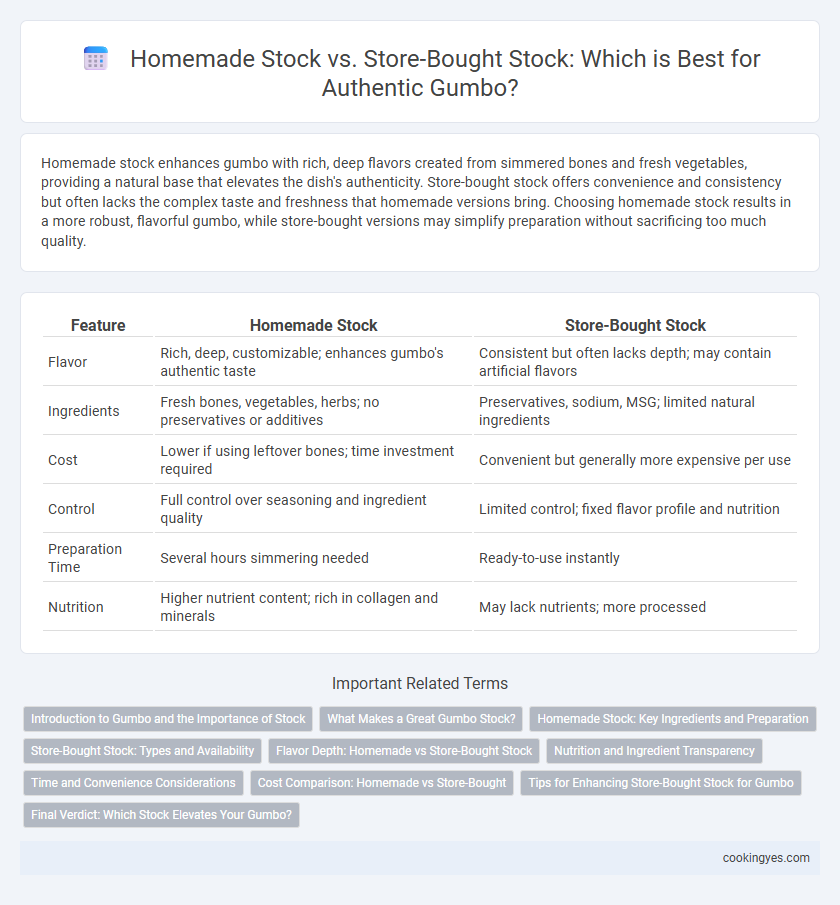Homemade stock enhances gumbo with rich, deep flavors created from simmered bones and fresh vegetables, providing a natural base that elevates the dish's authenticity. Store-bought stock offers convenience and consistency but often lacks the complex taste and freshness that homemade versions bring. Choosing homemade stock results in a more robust, flavorful gumbo, while store-bought versions may simplify preparation without sacrificing too much quality.
Table of Comparison
| Feature | Homemade Stock | Store-Bought Stock |
|---|---|---|
| Flavor | Rich, deep, customizable; enhances gumbo's authentic taste | Consistent but often lacks depth; may contain artificial flavors |
| Ingredients | Fresh bones, vegetables, herbs; no preservatives or additives | Preservatives, sodium, MSG; limited natural ingredients |
| Cost | Lower if using leftover bones; time investment required | Convenient but generally more expensive per use |
| Control | Full control over seasoning and ingredient quality | Limited control; fixed flavor profile and nutrition |
| Preparation Time | Several hours simmering needed | Ready-to-use instantly |
| Nutrition | Higher nutrient content; rich in collagen and minerals | May lack nutrients; more processed |
Introduction to Gumbo and the Importance of Stock
Gumbo's rich, deep flavor relies heavily on the quality of its stock, making homemade stock a superior choice for authenticity and taste complexity compared to store-bought options. Homemade stock allows for precise control over ingredients like aromatic vegetables, herbs, and flavorful bones, resulting in a nuanced base that elevates traditional Cajun and Creole gumbo recipes. While store-bought stock offers convenience, it often lacks the depth and customization needed to truly capture gumbo's signature hearty and layered flavor profile.
What Makes a Great Gumbo Stock?
A great gumbo stock is rich in depth and complexity, achieved by simmering chicken bones, sausage, and aromatic vegetables for several hours to extract maximum flavor and gelatin, creating a velvety texture. Homemade stock offers superior freshness, customized seasoning, and control over sodium levels, whereas store-bought stock often contains preservatives and lacks the nuanced, robust taste essential for authentic gumbo. The key components include roasted or simmered bones, mirepoix (onions, celery, bell peppers), and spices like bay leaves and thyme, which together develop the foundational flavor profile that defines an exceptional gumbo.
Homemade Stock: Key Ingredients and Preparation
Homemade stock for gumbo relies heavily on key ingredients such as chicken bones, shrimp shells, and a mirepoix of onions, celery, and bell peppers, which create a rich flavor base. Simmering these components for several hours extracts gelatin and deepens the stock's complexity, enhancing the gumbo's overall taste and texture. Fresh herbs like thyme and bay leaves added during preparation further elevate the aromatic profile, making homemade stock a superior choice over store-bought alternatives.
Store-Bought Stock: Types and Availability
Store-bought stock for gumbo comes in various types such as chicken, beef, seafood, and vegetable, each offering distinct flavors to enhance the dish. It is widely available in liquid, concentrated, and powdered forms, providing convenience and consistent taste. Many brands now offer low-sodium and organic options, catering to diverse dietary preferences while maintaining the rich, robust base essential for authentic gumbo.
Flavor Depth: Homemade vs Store-Bought Stock
Homemade stock for gumbo offers richer flavor depth, as it simmers slowly extracting gelatin, marrow, and aromatics from fresh bones and vegetables. Store-bought stock often lacks the complexity and body that homemade versions provide, resulting in a thinner, less robust gumbo base. Using homemade stock enhances umami and layered flavors critical to authentic gumbo.
Nutrition and Ingredient Transparency
Homemade stock for gumbo offers superior nutrition and ingredient transparency compared to store-bought options, as it contains natural nutrients from fresh bones, vegetables, and herbs without preservatives or artificial additives. This allows for greater control over sodium levels, allergens, and flavor profiles, enhancing the overall health benefits of the dish. Store-bought stock often contains hidden additives, high sodium content, and less natural collagen, which can compromise both the nutritional value and authentic taste of gumbo.
Time and Convenience Considerations
Homemade stock enhances gumbo's depth of flavor through slow simmering of bones and vegetables, requiring several hours that may challenge time constraints. Store-bought stock offers significant convenience by providing a ready-to-use liquid base, ideal for quick meal preparation without compromising kitchen efficiency. Choosing between homemade and store-bought stock depends on prioritizing rich, complex taste versus time-saving convenience when making gumbo.
Cost Comparison: Homemade vs Store-Bought
Homemade stock for gumbo typically costs less per batch when using leftover bones, vegetables, and seasonings compared to purchasing store-bought stock, which can range from $3 to $5 per quart. Despite the initial effort and time investment, homemade stock yields larger quantities with richer, customizable flavors, reducing overall gumbo preparation expenses. Store-bought stock offers convenience but often contains higher sodium and preservatives, potentially impacting both quality and health considerations.
Tips for Enhancing Store-Bought Stock for Gumbo
Enhance store-bought stock for gumbo by simmering it with aromatic vegetables like onions, celery, and bell peppers to deepen the flavor profile. Incorporate spices such as bay leaves, thyme, and crushed black peppercorns to mimic the complexity of homemade stock. To boost richness, add a splash of Worcestershire sauce or a small amount of homemade roux before combining with the gumbo ingredients.
Final Verdict: Which Stock Elevates Your Gumbo?
Homemade stock elevates gumbo by offering rich, complex flavors derived from simmered bones, vegetables, and spices, creating a depth unattainable in store-bought options. Store-bought stock often contains additives and lacks the robust taste, resulting in a less authentic gumbo experience. For an exceptional gumbo, homemade stock is the definitive choice to enhance flavor and authenticity.
Homemade stock vs store-bought stock for gumbo Infographic

 cookingyes.com
cookingyes.com